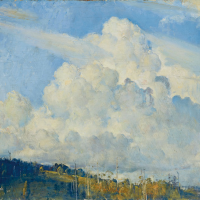66. TOM ROBERTS

We go on quietly Im doing no portraits, but am on, with fresh delight, to landscapes and here is a very tempting surrounding.1
Up here are the most wonderful clouds; one goes at em and is almost afraid to look next day at the result for fear of disappointment High piled up cumuli reared up over a shadowed hill are inspiring. They seem so still 2
In 1919 after twenty years living abroad, Tom Roberts returned to Australia. The visit enlivened Roberts and convinced him and his wife Lillie to return permanently in 1923. Australia, with its warm breezes, wildlife, and broad vistas, was the catalyst for Roberts to relocate to Sassafras (renamed Kallista) in the Dandenongs, where he lived until his death in 1931.
The paintings that date from Roberts return form a considered and small group. Modest in scale, they concentrate Roberts love of the environment and his sense of place. Roberts was enamoured of the bright light of Kallista, the trees, and the height of his surrounds: It all came back when I sat there with the blue sweep of the Ranges before me, and the sunshine warm and golden and the dear-remembered beauty.3
Roberts painting The Cloud 1925 has remained in the same family collection since 1930 and now appears for the first time at auction. There is an ease and light touch to The Cloud which is evident in other Roberts paintings of Kallista. Roberts describes the fore and middle ground in precise detail yet allows the cloud to remain soft and pendulous. Each element is in balance to the other in a painting that is both fact and allegory. Clouds, as Roberts suggested, seem so still . but the skill is in painting a fleeting moment.
The Roberts painting Mountain Clouds 1924 (National Gallery of Victoria collection, Melbourne) is similarly on board and is the same size as our present lot. Rather than the distant horizon and central cumulus of The Cloud, the view is taken contre-jour. Light pushes through the clouds and rakes the trees with shadow. Blues, yellows, and greens play through the middle of the painting and the effect is immediate, and transcendent. The landscape cambers from the right edge to the centre where our eye rests at the intersection of cloud and yellow-green hillside.
The Two Roads to Monbulk 1924 (private collection) painted a year previously prefigures our current lot. This sweeping composition occupies a statelier terrain. The view, expansive and detailed, is a panorama of beauty and calm. Roberts had great concern for the changing nature of landscape and recorded the felling and clearing of trees as did Arthur Streeton (1867-1943). It is implied in the denuded white and ailing trees in the foreground of this painting and distantly in the blanched trunks that match-stick through Roberts composition.
The blue sweep that Roberts found in the Dandenongs is here abundant. The view is surmounted by a cloud that pillows the distant ranges. Clouds remain paramount to an understanding of the late Roberts paintings and in The Two Roads to Monbulk, the cloud is a crown to Roberts well thought reflection. A sense of wellbeing that the artist found in the Australian landscape was not lost on the artist Jessie Traill (1881-1967) who had been close to Roberts in London and now observed him at Kallista: There in the quiet of the years that followed he painted, thought-out gentle landscapes they seemed removed from hurry; they had a joy and love in them, gained after years of seeking our own bush interpreted by one who loved it so. Roberts found hills so blue and dreaming distant; never trees on the nearer slope so finely traced; never clouds massed so bold and luminous 4
Time and weather transmuted through landscape is one of the great pleasures of picture making. Tom Roberts found this so but understood that painting was also an aide memoire, and the means to leave a trace of what was seen. The subject of artists and their late works is a discussion unto itself. Certain artists warm to age and prosper as others persist yet falter. Not so the late paintings of Tom Roberts. There is a consistency to this series and in The Cloud, Roberts has found his moment to reflect on lifes transience. A cloud is atmosphere, an adaption, but Roberts Cloud is about transcendence, and how a skilled painter such as he might capture this very essence.
Footnotes:
1. Tom Roberts, quoted in Gray, A., Tom Roberts, National Gallery of Australia, Canberra, 2015, p.300
2. Ibid.
3. Tom Roberts, quoted in Croll, R., Tom Roberts: Father of Australian Landscape Painting, Robertson and Mullens, Melbourne, 1935, p.121
4. Jessie Traill, quoted in Gray, A., op. cit., p.25
Brett Ballard